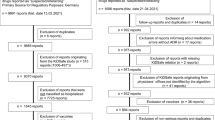Abstract
The safety of medications in paediatric patients is influenced by age- and drug-specific features, but clinical information on specific risk of medicines in this population is limited. In order to provide essential information that will help prevent harm to children, pharmacovigilance reports should include data on the patient characteristics and circumstances involved in the reported adverse drug reaction.
Similar content being viewed by others
References
Star K, Edwards IR. Pharmacovigilance for children’s sake. Drug Saf. 2014;37(2):91–8.
Permala J, Hassali MA, Awaisu A, et al. Dosing information in a standard drug reference: are pediatrics still therapeutically neglected? Pediatr Int. 2010;52(2):290–5.
Tan E, Cranswick NE, Rayner CR, et al. Dosing information for paediatric patients: are they really “therapeutic orphans”? Med J Aust. 2003;179(4):195–8.
Kimland E, Odlind V. Off-label drug use in pediatric patients. Clin Pharmacol Ther. 2012;91(5):796–801.
Horen B, Montastruc JL, Lapeyre-Mestre M. Adverse drug reactions and off-label drug use in paediatric outpatients. Br J Clin Pharmacol. 2002;54(6):665–70.
Bellis JR, Kirkham JJ, Nunn AJ, et al. Adverse drug reactions and off-label and unlicensed medicines in children: a prospective cohort study of unplanned admissions to a paediatric hospital. Br J Clin Pharmacol. 2014;77(3):545–53.
Bellis JR, Kirkham JJ, Thiesen S, et al. Adverse drug reactions and off-label and unlicensed medicines in children: a nested case–control study of inpatients in a pediatric hospital. BMC Med. 2013;11:238.
Pawar S, Kumar A. Issues in the formulation of drugs for oral use in children: role of excipients. Paediatr Drugs. 2002;4(6):371–9.
Kearns GL, Abdel-Rahman SM, Alander SW, et al. Developmental pharmacology: drug disposition, action, and therapy in infants and children. N Engl J Med. 2003;349(12):1157–67.
Kearns GL, Wilson JT, Neville KA, et al. Drug therapy in pediatric patients. In: van Boxtel CJ, Santoso B, Edwards IR, editors. Drug benefits and risks international textbook of clinical pharmacology. 2nd ed. Amsterdam: IOS Press; 2008. p. 181–201.
Kennedy M. Hormonal regulation of hepatic drug-metabolizing enzyme activity during adolescence. Clin Pharmacol Ther. 2008;84(6):662–73.
Wong IC, Ghaleb MA, Franklin BD, et al. Incidence and nature of dosing errors in paediatric medications: a systematic review. Drug Saf. 2004;27(9):661–70.
Conroy S, Sweis D, Planner C, et al. Interventions to reduce dosing errors in children: a systematic review of the literature. Drug Saf. 2007;30(12):1111–25.
Carmichael M. Drug safety: double jeopardy. Nature. 2013;498(7455):S14–5.
Diller L. Clinical practice: adult primary care after childhood acute lymphoblastic leukemia. N Engl J Med. 2011;365(15):1417–24.
Choonara I. Educational paper: aspects of clinical pharmacology in children—pharmacovigilance and safety. Eur J Pediatr. 2013;172(2):577–80.
Menniti-Ippolito G, Raschetti R, Da Cas R, et al. Active monitoring of adverse drug reactions in children. Italian Paediatric Pharmacosurveillance Multicenter Group. Lancet. 2000;355(9215):1613–4.
Couper MR, Kaplan SE. Promoting safety of medicines in children. Geneva: World Health Organisation; 2007.
Disclosure
This article was adapted from Drug Safety 2014;37(2):91–8 [1]. The preparation of these articles was not supported by any external funding.
Author information
Authors and Affiliations
Consortia
Rights and permissions
About this article
Cite this article
Adis Medical Writers. Pharmacovigilance reports of drug-related harms in children should include details on age- and drug-specific factors. Drugs Ther Perspect 30, 298–301 (2014). https://doi.org/10.1007/s40267-014-0127-3
Published:
Issue Date:
DOI: https://doi.org/10.1007/s40267-014-0127-3




